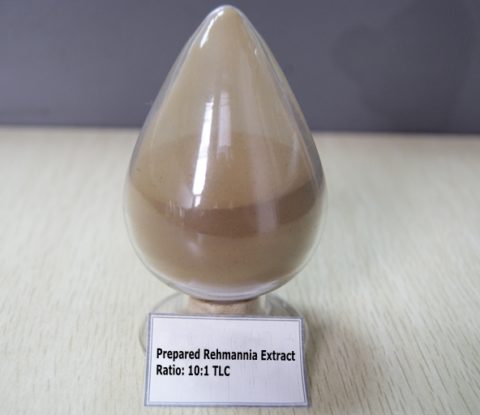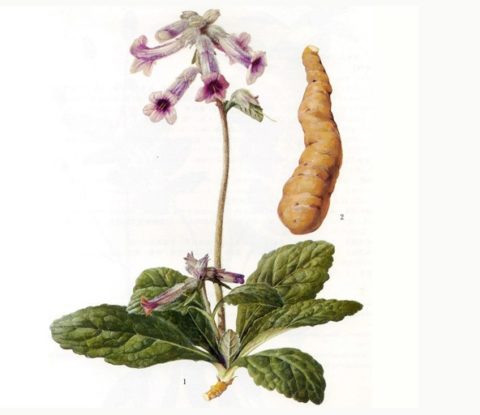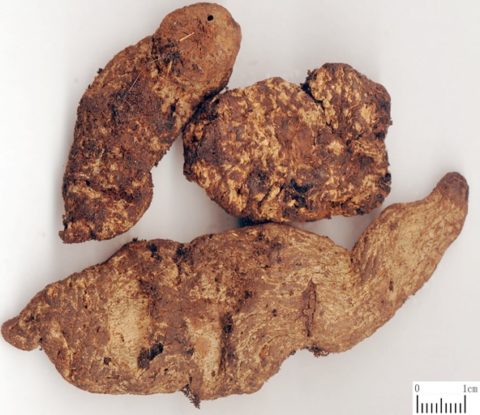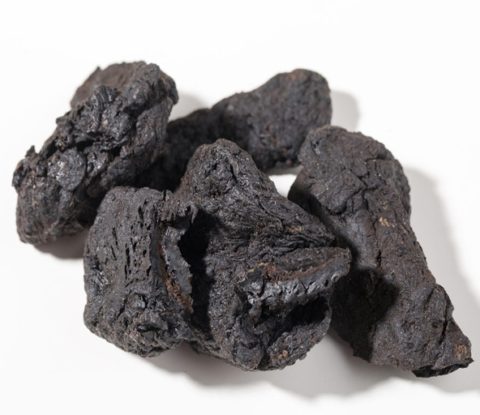
Prepared Rehmannia Extract
Prepared Rehmannia Root/Radix Rehmanniae Extract Powder
【Latin Name】: Rehmannia glutinosa (Gaertn.) Libosch EX Fisch.et Mey.
【Other names】: Sheng Di Huang, Sheng Di, Radix Rehmanniae, Rehmannia Root, Gan Di Huang
【Part of the Plant Used】: Root
【Solvent】: Hot water
【Product Specification】: 10:1, 20:1, 50:1
【Test method】: TLC
【Particle size】: 95% pass 80 mesh size
【Benefit】: Nourish Kidney-yin and help promote kidney function thus improved sex libido
Brief Introduction
Rehmannia (Radix Rehmanniae) is considered a blood and yin tonic in Traditional Chinese Medicine. Rehmannia health benefits include strengthening the kidneys, strengthening the adrenal glands, and tonifying the blood. Many of the herbal formulas used here at Natchez Trace Veterinary Services contain Rehmannia as one of the main ingredients, so we thought you may be interested in the history, use and effects of this amazing herb. One of the Traditional Chinese Medicine Rehmannia blends used in our clinic is Rehmannia Assist Kidney. In Traditional Chinese Theory, kidney failure and kidney meridian dysfunction are a direct result of an imbalance of yin and yang. Rehmannia Assist Kidney helps re-balance the yin and yang with it’s cooling herbs that nourish and tonify the kidney and it’s yin (fluids), bringing the kidney back to its best functioning condition.
Chemical Composition
The major chemical constituents of the herb are polysaccharides and iridoid monoterpenes (eg, catalpol, ajugol, aucubin, rehmanniosides, monomelittoside, melittoside, verbascoside, jionosides). Two acidic polysaccharides, rehmannans SA and SB, were isolated from the dried root of R. glutinosa of Chinese origin. These polysaccharides were composed of differing molar ratios of L-arabinose, D-galactose, L-rhamnose, and D-galacturonic acid. Additional polysaccharides have been isolated. Pharmacological activity of the plant species varies depending on processing (dried or steamed) and location of cultivation (eg, Japan versus China). Other sesquiterpenoids and furans have been isolated.
Indications in TCM
1. Heat entering nutrient-blood in warm diseases
It can cool blood, stop bleeding, nourish yin especially for nutrient-yin deficiency or bleeding due to blood heat in nutrient-blood system and it excels in clearing heat especially in nutrient-blood system in warm diseases. For heat syndrome in nutrient and blood systems leading to nutrient-yin consumption manifested as fever aggravated at night, thirsty, red tongue without coating, it is often combined with herbs of clearing heat from qi system and herbs of clearing heat and removing toxicity so as to clear nutrient and transfer heat out, such as Jin Yin Hua, Lian Qiao, Zhu Ye in Qing Ying Tang from Wen Bing Tiao Bian. For heat syndrome in blood system under the condition of both blood heat with excessive toxicity manifested as coma, delirium, crimson tongue and bleeding due to blood heat manifested as hematemesis, apostaxis, hematochezia, macula in dark purple color, it is commonly combined with herbs excelling in activating blood and resolving stasis, clearing heat and cooling blood for the purpose of mutually reinforced the effects of heat-clearing, stasis-resolving, blood-cooling and bleeding-stopping. For example, Shui Niu Jiao, Chi Shao, Mu Dan Pi in the formula Xi Jiao Di Huang Tang from Qian Jin Fang. For heat disease in terminal stage with lingering heat manifested as fever aggravated at night while alleviated at morning, red tongue and rapid pulse, it is combined with deficiency-heat-clearing herbs for mutual reinforcement such as Zhi Mu, Qing Hao, in Qing Hao Bie Jia Tang from Wen Bing Tiao Bian, in which Di Huang plays the role as clearing lingering heat in blood as well as nourishing yin to promote body fluid.
2. Bleeding due to blood heat
It is commonly indicated for hematemesis, emptysis, hemoptysis, hemafecia, hematuria, metrorrhagia and metrostaxis caused by excessive heat in zang-fu organs forcing blood because of its actions of stopping bleeding and cooling blood as well. It is often combined with herbs of cooling blood and stopping bleeding, such as Raw Ce Bai Ye, Raw He Ye in the formula Si Sheng Wan from Fu Ren Da Quan Liang Fang (Effective Prescriptions for Women).
3. Syndrome of yin deficiency
It can nourish yin, clear heat as well as nourish yin in zang-fu organs to purge fire, moisten dryness and promote fluid production, so it excels in treating thirsty and constipation in dryness-heat syndrome due to yin-deficiency especially for stomach yin deficiency by its action of promoting fluid production. For syndrome of interior heat caused by yin-deficiency manifested as bone-steaming tidal fever, it is often combined with herbs of nourishing yin and purging fire, such as Zhi Mu and Di Gu Pi, etc. For body fluid deficiency and polydipsia in warm disease. It is often combined with stomach-yin-nourishing herbs to promote body fluid and relieve thirst, for instance, Mai Dong, Bei Sha Shen, Yu Zhu, as in Yi Wei Tang recorded in Wen Bing Tiao Bian. For yin-deficiency syndrome manifested as diabetes and polydipsia, it is reinforced by the combination with qi-replenishing and body-fluid-promoting herbs like Shan Yao, Huang Qi and Shan Zhu Yu, etc. For intestine dryness and constipation due to yin consumption, it is combined with herbs of nourishing yin and moistening dryness to mutually take effects of increasing fluid and relaxing bowels, for example, Xuan Shen and Mai Dong, etc., as in Zeng Ye Tang from Wen Bing Tiao Bian. For chest, stomach and hypochrondriac pain as well as dry mouth and throat caused by liver and kidney yin-deficiency which lead to blood and body fluid consumption, it is often combined with herbs of nourishing yin and moistening dryness, such as Sha Shen, Mai Dong and Gou Qi, as in Yi Guan Jian from Liu Zhou Yi Hua (Liuzhou Medical Talks). For syndrome of lung and kidney yin-deficiency with symptoms as dry cough and hemoptysis, it is reinforced by the combination with lung-yin-nourishing and cough-stopping herbs. For instance, Bai He, Bei Mu, Xuan Shen and so on in Bai He Gu Jin Tang from Yi Fang Ji Jie. For restless and insomnia caused by heart and kidney yin-deficiency, it is commonly combined with other yin-nourishing, dryness-moistening and tranquilizing herbs, such as Tian Dong, Mai Dong, Wu Wei Zi and so on in Tian Wang Bu Xin Dan recorded in She Sheng Mi Pou (Secrets of Health Preservation).
Modern Researches on Pharmacological Effects
Rehmannia is most commonly used in combination with other herbs, and clinical trials providing evidence for a definitive place in therapy are lacking.
1. CNS effects
Catalpol is being studied for its neuroprotective effects, with potential applications in Alzheimer and Parkinson diseases, as well as in ischemia and other conditions associated with aging. Clinical trials are lacking. In in vitro studies and animal models of aging, catalpol exerts antioxidant effects on glial cell cultures, protects against beta-amyloid–induced apoptosis, increases hippocampal neuroplasticity, and upregulates gene expression of glial cell-line-derived neurotrophic factor, among other suggested mechanisms. Increased sleeping time in mice has been observed in phenobarbital-induced sleep as well as, antagonism of caffeine-induced excitability and antidepressant effect of chronic stress.
2. Diabetes
Decreased hyperglycemia was demonstrated in several animal studies in which diabetes had been induced. Suggested mechanisms of action for aqueous or methanol R. glutinosa extracts, oligosaccharide, catalpol, rehmannioside D, or other polysaccharide extracts include decreasing glucose-6-phosphatase and fructokinase activity, decreasing plasma C-reactive protein, increasing hepatic glycogen content and pancreatic insulin release, and decreasing insulin resistance. Additionally, protective effects were documented for diabetic nephropathy and obesity in animal models, while others reported no effect on plasma cholesterol or triglycerides. Despite the use of R. glutinosa in traditional Chinese medicine for the treatment of diabetes, clinical trials are lacking.
3. Hematology
A 50% ethanolic extract of R. glutinosa inhibited decreases in fibrinolytic activity and erythrocyte deformability, decreases in erythrocyte counts, and increases in connective tissue in rodents. The extract was ineffective in reducing edema and acute or chronic inflammation. R. glutinosa prevented decreases in erythrocyte deformability in rats with endotoxin-induced disseminated intravascular coagulation. In normal rats, R. glutinosa enhanced or increased erythrocyte deformability and fibrinolytic activity. Effects on the hemopoietic system have also been described based on in vitro studies.
4. Immune system
In animal studies, R. glutinosa has exerted effects on the immune system, including T-lymphocyte activity, histamine release and tumor necrosis factor, and hemolytic plaque-forming cells. The polysaccharide extracts jionoside and acetoside have been evaluated; however, clinical trials are lacking. Studies in animals have demonstrated Rehmannia Six Formula (a combination preparation in which Rehmannia is the majority herb) as a potential oral adjuvant in immunization. A large and sustained rise in immunoglobulin G response occurred with antitetanus and diphtheria toxoid.
5. Other effects
Antioxidant effects have been described in several experiments, including in auditory cells.
Atopic eczema
A limited number of clinical trials have been conducted using a combination of 10 herbs, including Rehmannia ( Zemaphyte ). However, findings from these trials cannot be attributed to any single plant.
Cancer
Reductions in apoptosis have been observed in vitro with steamed root extracts in UV-stimulated cells and in hepatocellular carcinoma. Antitumor effects have also been described for R. glutinosa polysaccharides, as well as increases in T-lymphocyte production.
Gastric ulcer
A reduction in ethanol-induced gastric mucosal damage was demonstrated with an aqueous extract of the root. Inhibition of gastric acid secretion was shown in animal studies.
Inflammation
An anti-inflammatory effect in animal models has been shown for Radix rehmanniae but not for ethanol extracts. In a poorly described clinical study, arthritis symptoms, including reduced joint pain and swelling, improved and joint mobility increased.
Osteoporosis
R. glutinosa extracts may enhance bone metabolism in osteoporosis by stimulating the proliferation and activity of bone-forming osteoblasts as well as inhibiting generation and activity of bone-resorbing osteoclasts. The extract may also increase the expression of bone-related genes. In vivo studies using ovariectomy-induced osteoporotic rats showed an alleviation of decreased trabecular bone mineral density and increased cortical bone thickness and trabeculation of bone marrow spaces.
Renal
A protective effect of plant ethanol extracts was demonstrated in animal models of renal failure and diabetic nephropathy.
Wound healing
In animal models of diabetic foot ulcers, enhanced fibroblast cell viability occurred, as well as a trend toward decreased wound area and greater epithelialization.








